Gennaro Cuofano's Blog, page 16
September 15, 2025
The Gatekeepers of Attention
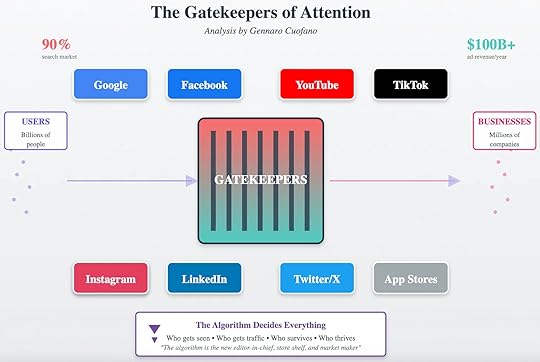
Every business today is in the attention business. Whether you’re a global brand or a local startup, growth depends on being seen, clicked, and remembered. But the path from user to business is not open—it passes through a small set of gatekeepers.
Google controls 90% of search.Facebook, Instagram, and LinkedIn own professional and social discovery.YouTube dominates video.TikTok rewired cultural relevance for an entire generation.App stores decide which digital products even get shelf space.These platforms sit between billions of users and millions of businesses, capturing more than $100 billion a year in advertising revenue for the privilege.
Algorithms as Market MakersGatekeeping isn’t just about access. It’s about algorithms.
Algorithms decide who gets seen.Algorithms decide who gets traffic.Algorithms decide who survives—and who thrives.The editor-in-chief, the store shelf, and the market maker have collapsed into a single black box. If the algorithm favors you, growth is exponential. If not, you vanish into obscurity.
As one founder put it:
The Two-Sided Dependency“Distribution is no longer about merit—it’s about the feed.”
These gatekeepers create a two-sided market dynamic:
UsersBillions of people spend their daily attention inside these platforms.The feed simplifies the world into endless scrolls, swipes, and suggested links.BusinessesMillions of companies depend on visibility within those feeds.Entire industries—from media to e-commerce—are shaped by algorithmic exposure.The result is a massive dependency lock-in: businesses can’t avoid gatekeepers, and users rarely leave them.
The Hidden Cost of AttentionBusinesses often underestimate the hidden costs of depending on gatekeepers:
Rising Rents: As organic reach declines, paid reach becomes the only reliable path.Opaque Rules: Algorithm shifts can erase traffic overnight without explanation.Winner-Takes-All Dynamics: A handful of creators, brands, or apps capture outsized visibility, while the rest compete for scraps.Platform Risk: A ban, suspension, or ranking penalty can destroy years of accumulated audience.Attention comes with a toll—and the toll is rising.
Why Gatekeepers WinThree structural advantages ensure gatekeepers remain entrenched:
Network EffectsMore users create more data, which improves algorithms, which attracts more users.Each additional participant strengthens the moat.Algorithmic PowerAlgorithms don’t just reflect attention—they manufacture it.By controlling ranking and recommendation, gatekeepers engineer demand flows.Default BehaviorsUsers don’t “choose” discovery—they follow defaults.Google is the homepage. TikTok is the downtime filler. LinkedIn is the career hub.Gatekeeping works not because users are forced—but because defaults shape reality.
The Business Model of GatekeepingThe logic of the model is simple:
Users provide attention and behavioral data.Algorithms transform that data into ranked feeds.Businesses pay to insert themselves into those feeds.This creates a self-reinforcing cycle:
More users mean more data.Better targeting increases ad performance.Higher ROI draws more business spend.The cycle explains why digital advertising is not just resilient but dominant—even in downturns.
Cracks in the ModelBut cracks are emerging:
User Fatigue: Younger generations distrust advertising and seek authenticity.Regulation: Antitrust scrutiny in the US and EU is targeting gatekeeper dominance.AI Disruption: Conversational agents threaten to disintermediate traditional feeds by collapsing discovery into dialogue.If AI becomes the default discovery layer, gatekeepers risk losing their privileged position as attention brokers.
Strategic Responses for BusinessesFor businesses, the challenge is clear: you cannot ignore gatekeepers, but you also cannot depend solely on them.
1. Diversify DistributionSpread attention bets across multiple platforms.Avoid overexposure to a single algorithm’s whims.2. Build Owned ChannelsNewsletters, podcasts, and communities provide insulation from gatekeeper risk.Direct relationships are the only hedge against algorithmic volatility.3. Play the Feed, but Don’t Depend on ItOptimize for visibility—short-form video, platform-native content—but treat it as rented space.Use it to funnel users into owned assets.4. Experiment with Emerging LayersAI-driven discovery (ChatGPT, Perplexity, Claude) is already shifting user habits.Early movers can establish presence before the new gatekeepers consolidate power.The Key InsightThe battle for attention is not really between businesses. It is between businesses and gatekeepers.
Businesses fight for scraps of algorithmic visibility.Gatekeepers monetize the battlefield itself.The deeper truth: attention is no longer a market—it is a managed commodity.
And in a managed commodity market, the only way to win long-term is to either:
Become a gatekeeper.Or escape their control by building something they can’t algorithmically tax.Closing ThoughtThe internet was once imagined as a decentralized frontier. In reality, it has condensed into a handful of gatekeepers of attention.
They decide who gets seen, who grows, and who fades. Their algorithms are invisible, but their impact is total.
For businesses, the challenge is not just to capture attention—it is to navigate the algorithmic choke points that control it.

The post The Gatekeepers of Attention appeared first on FourWeekMBA.
Why Infrastructure Power Shapes the Entire Digital Economy
 The Hidden Bedrock
The Hidden BedrockMost people think of the internet as Google searches, TikTok videos, or Amazon shopping carts. But underneath lies an invisible structure without which none of it exists: the foundational infrastructure of the web.
This base layer rarely enters public conversation. Yet it is where power is most concentrated, margins are most defensible, and fragility is most dangerous.
When this layer fails, the consequences are immediate and systemic:
An AWS outage takes down a third of the internet.A Cloudflare disruption makes millions of sites unreachable.The foundation nobody sees is also the foundation nobody questions—until it breaks.
The Three-Layer Stack of Internet Infrastructure1. Foundation InfrastructureProtocols like TCP/IP, DNS, HTTP/HTTPS, and web standards form the technical rules that every service must obey. These aren’t optional—they’re the non-negotiable grammar of the internet.
Power Source: Absolute necessity, no alternatives, invisible control.Value Extraction: Infrastructure rent, service fees, and data transit costs.As the saying goes:
2. Physical Network Infrastructure“You don’t negotiate with internet protocols. You simply build on top of them.”
This layer is the hardware backbone:
Submarine cables that carry global data.Data centers that host the cloud.ISPs and CDNs that route and optimize flows.It’s capital-intensive, geographically strategic, and politically sensitive. Whoever owns these assets holds leverage far beyond the consumer’s line of sight.
3. Cloud Infrastructure OligopolyHere sit the modern gatekeepers:
AWS (Amazon)Azure (Microsoft)GCP (Google)Cloudflare (edge networks and security)Together, they operate as an oligopoly: a small set of firms providing indispensable services to every startup, publisher, and enterprise. Switching is costly, alternatives are limited, and outages ripple across industries.
The Nature of Power at the BottomPower at the foundation doesn’t look like consumer branding or viral reach. It looks like invisible necessity.
Absolute Dependence: Every higher layer—from social platforms to SaaS apps—relies on this infrastructure.No Substitutes: Unlike apps or tools, there are no viable competitors to TCP/IP or DNS. And there are only three hyperscale cloud providers capable of serving the planet.Silent Toll Extraction: Infrastructure players don’t need to innovate at the speed of consumer apps. They just collect rent—charging for compute, storage, bandwidth, and transit.This combination makes the bottom layers the least visible but most profitable segments of the digital economy.
Fragility and ConcentrationThe paradox is that while these layers feel unshakable, they are also fragile.
A software bug at Cloudflare can knock entire regions offline.A legal dispute over submarine cables can disrupt financial flows.A geopolitical crisis can turn cloud data centers into national-security assets.This fragility is compounded by concentration: with so much infrastructure controlled by so few players, single points of failure have systemic impact.
Historical Blind SpotsUsers, businesses, and even policymakers often miss the importance of foundational infrastructure because:
It’s Invisible: Most people never interact directly with protocols or cables.It’s Assumed: Like electricity, it’s expected to “just work.”It’s Abstract: Outages are seen as temporary glitches, not structural risks.Yet history shows these blind spots matter. Every AWS outage creates cascading effects on SaaS companies, retailers, and even government services. Every DNS misconfiguration can trigger hours of downtime across thousands of businesses.
The Strategic ImplicationsInfrastructure Sets the BoundariesNo matter how innovative you are at the application layer, you remain constrained by the rules, costs, and fragility of the foundation.Cloud Dependency Is TotalStartups don’t just “use” AWS or Azure—they are entirely embedded in their pricing structures, availability zones, and outages. Cloud choices shape both business models and margins.Policy and Geopolitics IntrudeSubmarine cables and data centers are now treated as strategic assets. National security concerns increasingly dictate where and how infrastructure is built.Resilience as StrategyBusinesses must design for redundancy—multi-cloud deployments, CDN failovers, edge computing—to reduce dependence on a single chokepoint.The AI Era and Infrastructure BottlenecksAI accelerates the importance of the foundation layer. Training foundation models, serving real-time inference, and running agentic systems require:
Massive GPU clusters.Specialized data center cooling.Global low-latency delivery.NVIDIA may dominate chips, but cloud infrastructure controls deployment. Without AWS, Azure, or GCP, AI innovation cannot scale globally.
Thus, in the AI era, the foundation is not just invisible—it’s a bottleneck.
Closing InsightIn the Digital Distribution Pyramid, the foundation was the least glamorous but most powerful layer. The same holds here.
Infrastructure doesn’t innovate as visibly as apps, but it extracts value more predictably.When it fails, the internet breaks. When it holds, nobody notices.The foundation nobody sees is the foundation everybody depends on.
The real lesson: if you want to understand where control lives in the digital economy, don’t look at the apps in your hand—look at the cables, clouds, and protocols underneath.

The post Why Infrastructure Power Shapes the Entire Digital Economy appeared first on FourWeekMBA.
The Digital Distribution Ecosystem Pyramid
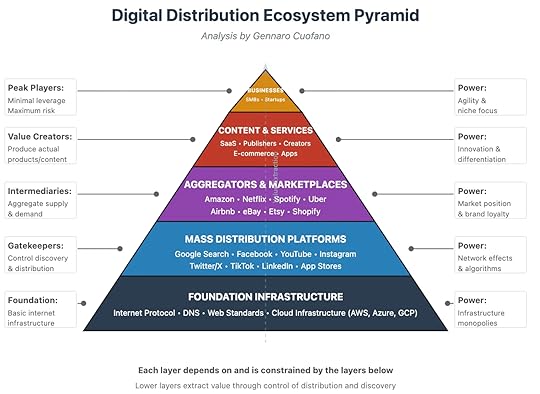
How Value and Power Flow in the Online Economy
Framework by Gennaro Cuofano, The Business Engineer
The internet economy isn’t flat—it’s structured like a pyramid of dependency. At the base are the protocols and infrastructure that make the web function. At the top sit businesses, creators, and startups trying to capture customer attention.
The pyramid shows a hard truth: value flows upward, but power concentrates downward. Each layer extracts value from the one above it through control of infrastructure, discovery, and distribution.
Layer 1: Foundation InfrastructureAt the bottom is the plumbing of the internet.
Internet Protocol, DNS, and web standards.Cloud infrastructure from AWS, Azure, and GCP.This layer doesn’t create consumer experiences but controls the conditions for everything else. Infrastructure monopolies like Amazon Web Services or Microsoft Azure can dictate terms because businesses literally can’t function without them.
Power: Infrastructure monopolies.
Layer 2: Mass Distribution PlatformsOn top of the foundation sit the distribution giants:
Search (Google)Social (Facebook, Instagram, TikTok, Twitter/X, LinkedIn)Video (YouTube)App stores (Apple, Google Play)These companies control discovery, recommendation algorithms, and traffic flows. They decide who gets visibility. Their weapon is scale: network effects, algorithmic feeds, and monopolistic control over attention.
Power: Network effects and algorithms.
Layer 3: Aggregators & MarketplacesNext are the demand aggregators—platforms that bring together buyers and sellers at scale:
Amazon for retail.Netflix and Spotify for content.Uber and Airbnb for services.Etsy, Shopify, eBay for niche commerce.Their strength lies in brand loyalty and market position. Once consumers habitually search Amazon before Google for products, Amazon captures the higher-margin position in the stack.
Power: Market position and brand loyalty.
Layer 4: Content & ServicesAbove aggregators are the actual producers:
SaaS providers.Publishers.Creators.E-commerce apps.This is where innovation and differentiation happen. But content providers remain dependent on the layers below for distribution. Publishers live and die by Google search rankings. Creators depend on TikTok’s algorithm. SaaS companies rely on cloud infrastructure.
Power: Innovation and differentiation.
Layer 5: BusinessesAt the very top are businesses—SMBs and startups—trying to build brands, products, and customer relationships.
These peak players carry maximum risk and minimal leverage. They rely on infrastructure, platforms, and aggregators for everything from hosting to traffic to payments. One algorithm change or fee increase can destroy their economics overnight.
Power: Agility and niche focus—but fragile.
The Dependency FlowThe pyramid makes one principle clear:
A Shopify merchant depends on Shopify (aggregator), which depends on Google Ads (distribution), which depends on AWS (infrastructure).A SaaS startup depends on Azure cloud hosting, relies on LinkedIn ads for customer acquisition, and must navigate Apple or Google app store rules if mobile-first.Each layer depends on and is constrained by the layers below.
At every stage, control sits below value creation.
Why Lower Layers Extract MoreThe bottom layers operate like toll roads. They don’t need to innovate at the same pace as the upper layers because they control gateways.
Google doesn’t need to make the best content—it just needs to control how content is found.AWS doesn’t need to build consumer apps—it just needs to make itself indispensable as the computational substrate.The higher you go, the more creative freedom you have—but the less leverage you hold.
Implications for BusinessesFragile Positioning at the TopSMBs and startups innovate, but they’re easily crushed by changes at lower layers.Example: publishers wiped out by Google’s algorithm updates or Facebook’s pivot to video.Aggregator CaptureMarketplaces like Amazon capture consumer demand and commoditize suppliers.Sellers innovate on product, but aggregators capture the brand relationship.Platform RiskContent and services depend on the whims of app stores or search ranking systems.Building on “rented land” remains the biggest strategic risk.Strategic Escape RoutesIf you’re building at the top of the pyramid, survival requires mitigating dependency.
Own distribution: Build direct channels—email lists, communities, first-party data.Leverage multi-platform presence: Don’t rely on a single gatekeeper for traffic.Move down the stack: Some companies escape fragility by building infrastructure themselves. Shopify started as a SaaS product but expanded into payments, logistics, and infrastructure.The further down the pyramid you move, the more control you gain—but the higher the capital requirements.
The Pyramid in the AI EraAI reshuffles the pyramid but doesn’t erase it.
Foundation: Now includes GPUs (NVIDIA), foundation models (OpenAI, Anthropic), and cloud AI services.Distribution: Conversational agents and AI interfaces (ChatGPT, Gemini, Copilot) may replace search boxes.Aggregators: AI-native marketplaces will form around data, models, and vertical agents.Content: AI-generated services flood the layer, increasing dependence on distribution filters.Businesses: Must learn to design for AI visibility, not just SEO or app store rankings.AI shifts the battleground but keeps the pyramid intact: power remains with whoever controls the bottom layers.
Closing ThoughtThe Digital Distribution Ecosystem Pyramid is more than a static diagram—it’s a lens to understand where power concentrates and where fragility lies.
If you’re building at the top, agility is your weapon, but dependency is your weakness. The enduring lesson:
Value may flow upward, but control always flows downward.

The post The Digital Distribution Ecosystem Pyramid appeared first on FourWeekMBA.
The Current Inflection Point in AI
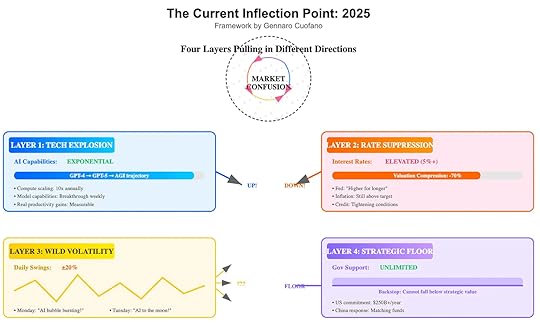 The Context: Four Layers, One Market Confusion
The Context: Four Layers, One Market ConfusionThe year 2025 marks an inflection point for technology and markets. We’re in a rare moment where four structural layers are pulling in opposite directions:
Exponential tech growth pushing valuations upward.Rate suppression compressing valuations downward.Volatility cycles creating daily chaos.Strategic floors holding up sectors deemed too critical to fail.The result? Market confusion. Investors, operators, and policymakers alike are caught in the crossfire between technological inevitability and financial headwinds.
Layer 1: The Tech ExplosionAt the core, AI capabilities are compounding exponentially.
Compute scales 10x annually.Breakthroughs arrive weekly.Productivity gains are measurable across industries.The trajectory from GPT-4 to GPT-5 to AGI-like systems is not theoretical. It’s unfolding in real time, reshaping workflows, industries, and expectations.
On pure technology fundamentals, valuations should be screaming upward. But markets rarely price pure reality — they price through filters.
Layer 2: Rate SuppressionThe first distorting filter is the interest rate regime.
Fed policy remains “higher for longer.”Rates sit above 5%.Inflation, though cooled, is still above target.Credit conditions are tightening.At these levels, the present value of future cash flows is crushed. High-duration assets like AI startups, robotics firms, and cloud infrastructure are repriced down 70% or more.
This creates the paradox: just as AI breakthroughs accelerate, valuations are mechanically compressed by monetary policy.
The market sees “AI miracles” on the ground but “AI bubbles” on the charts.
Layer 3: Wild VolatilityBetween exponential progress and rate suppression lies a layer of chaos: market volatility.
Daily swings of ±20% are becoming common.
Monday: Headlines scream “AI bubble bursting!”Tuesday: Narratives flip to “AI to the moon!”This isn’t random noise. It’s the clash between short-term narrative cycles and long-term technological certainty. Traders chase momentum, while institutions struggle to form conviction in the face of such violent reversals.
Volatility amplifies confusion. Instead of pricing fundamentals, markets oscillate between euphoria and despair.
Layer 4: The Strategic FloorThen comes the fourth layer: geopolitical necessity.
Governments cannot allow strategic technologies to collapse, regardless of market cycles.
The U.S. has committed $250B+ per year in direct and indirect AI, semiconductor, and infrastructure support.China is matching with equivalent funds.Europe, Japan, and the Middle East are following with sovereign commitments.This creates a strategic floor. No matter how much rates compress valuations, there is a level below which capital will not allow critical industries to fall.
AI is no longer just a market sector. It’s a matter of national competitiveness and security.
The Market ConfusionWhen all four forces interact, the outcome is not clarity but confusion.
Tech Explosion: Pushes valuations up.Rate Suppression: Forces valuations down.Volatility: Masks long-term trends with short-term noise.Strategic Floors: Prevents full collapse, holding valuations artificially high.Investors face a reality where price signals are broken. Markets no longer reflect the underlying trajectory of technology. They reflect the tug-of-war between exponential innovation, financial compression, speculative volatility, and geopolitical override.
Why 2025 Is DifferentThis is not another dot-com bubble. The technology is real, deployed, and scaling. Productivity effects are visible across software engineering, design, healthcare, logistics, and education.
But the financial environment is the opposite of the 1990s. Instead of low inflation, falling rates, and globalization, we have sticky inflation, high rates, and geopolitical fragmentation.
The inflection point of 2025 is defined by this contradiction:
The fastest technological acceleration in history.The tightest financial conditions in a generation.Strategic ImplicationsFor InvestorsTraditional valuation models break down.Short-term multiples are distorted by rates, not fundamentals.Long-term conviction requires a thesis on policy floors, not just cash flows.For OperatorsExecution matters more than timing markets.Focus on productivity gains that show resilience under high-rate regimes.Align with government-backed programs to secure funding immunity.For PolicymakersRate hikes aimed at inflation suppression risk slowing the very innovations needed for long-term productivity.Strategic overrides will increasingly conflict with monetary orthodoxy.Coordination between Fed policy and industrial strategy becomes essential.The Road AheadThe “current inflection point” is not about choosing between optimism or pessimism. It’s about recognizing layered contradictions.
Tech will not slow down.Rates will not drop quickly.Volatility will not disappear.Governments will not step back.Navigating 2025 requires embracing this complexity: markets can remain confused while technology advances unstoppably.
Closing ThoughtThe great mistake of 2025 will be assuming the market is telling the truth about technology. It isn’t.
Markets are mirrors distorted by rates, narratives, and geopolitics. The real signal is in the ground truth of exponential progress and government commitment.
The inflection point of 2025 is not the bursting of a bubble. It is the moment when financial gravity collides with technological inevitability.

The post The Current Inflection Point in AI appeared first on FourWeekMBA.
September 14, 2025
The Demographic Destiny, The Paradigm Shift in Motion
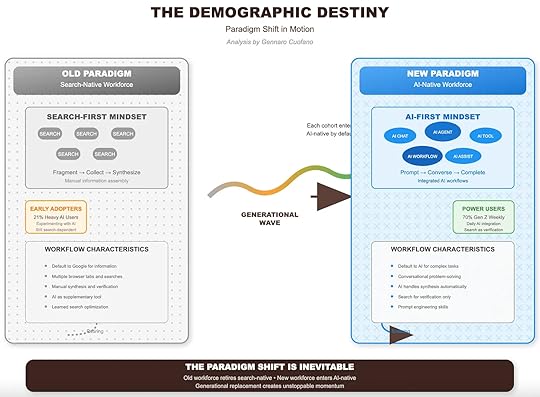
Technological revolutions don’t spread evenly. They cascade through society along demographic lines, with adoption patterns shaped less by features and more by generational mindset. What we are witnessing today is not just the rise of AI as a tool — it’s the generational replacement of a search-native workforce by an AI-native workforce.
That transition is destiny. Each cohort entering the workforce now arrives with AI-first reflexes, while older cohorts, shaped by decades of search-based workflows, gradually retire. This demographic shift ensures the paradigm transition is inevitable, regardless of short-term corporate hesitation.
From Search-First to AI-FirstThe old paradigm was defined by a search-first mindset. Workers defaulted to Google for information, stacking multiple tabs, refining queries, and manually synthesizing answers. Productivity depended on individual skill at navigating the search ecosystem: writing good queries, cross-checking results, and assembling fragments into coherent insights.
Workflow Characteristics of the Search-Native Era:Fragmented information collectionManual synthesis and verificationLearned search optimization as a key skillAI as a supplementary, experimental toolEven early adopters of AI within this paradigm (roughly 21% of heavy AI users) remained search-dependent, using AI experimentally but falling back on Google for validation and reliability.
Contrast this with the new paradigm: the AI-native workforce. For these cohorts, AI is not a supplement but the default. Search exists only as a backstop — a verification tool when needed.
Workflow Characteristics of the AI-Native Era:Default to AI for complex tasksConversational problem-solving through chat interfacesAutomatic synthesis built into workflowsSearch used for verification, not discoveryPrompt engineering and orchestration as learned skillsThis shift isn’t about preferences. It’s about habits formed during formative years. Gen Z power users already show that over 70% engage with AI weekly, and for them, “search” is no longer the starting point.
The Generational WaveGenerational transitions work like tides. They don’t need permission, and they don’t reverse. The search-native workforce is retiring while the AI-native workforce is entering by default.
This wave has three important consequences:
Adoption Is InexorableEven if enterprises resist, the workforce itself shifts the balance.Organizations slow to adopt AI will be forced to catch up as younger employees bring AI-first workflows to every role.Search Optimization Loses ValueDecades of learned skill in query crafting, SEO strategies, and manual synthesis erode in relevance.Efficiency no longer comes from finding the best link — but from framing the best prompt.Cultural Reset in WorkflowsWork is no longer about hunting for fragments but conversing toward completion.Tasks collapse from fragmented sequences into integrated AI workflows.The demographic shift guarantees that resistance to AI adoption is temporary. What looks like experimentation today becomes cultural default tomorrow.
Why Organizations Underestimate the ShiftMany executives misjudge this transformation because they focus on technology readiness rather than demographic inevitability.
Technology Readiness View:“We’ll adopt AI when the tools are proven, secure, and fully ROI-positive.”Demographic Destiny View:
“Whether or not leadership is ready, the incoming workforce is already AI-native.”
The result is a strategic blind spot. By waiting for clarity, companies risk creating friction between AI-native employees and legacy processes. This generational mismatch slows productivity and creates frustration, especially as younger cohorts bring their own tool stacks into the workplace.
Search as Verification, Not DiscoveryThe most profound shift is the repositioning of search itself. In the AI-native paradigm, search no longer leads the workflow. Instead, it becomes a verification layer.
Search-native mindset: Search → Collect → SynthesizeAI-native mindset: Prompt → Converse → Complete → VerifyThis inversion erodes the economic foundation of the open web. If discovery no longer starts in search, then publishers lose visibility and search engines lose their monopoly on workflow initiation.
For organizations, this means SEO as a growth lever will steadily decline. The real leverage moves to AI visibility: how, when, and where your brand appears in AI-mediated interactions.
Implications for StrategyThe demographic destiny reframes how companies must think about transformation:
Workflow RedesignInstead of bolting AI onto legacy processes, redesign work around AI-native behaviors.Optimize for conversational inputs, real-time synthesis, and agent orchestration.Skill ShiftsSearch optimization fades, while prompt design, context engineering, and agent orchestration rise as core skills.Training programs must reflect this, shifting investment away from “search literacy” to “AI fluency.”Competitive DifferentiationCompanies that align early with AI-native workflows will attract and retain AI-native talent.Those that cling to search-native systems will find themselves outpaced not just technologically, but demographically.Long-Term Cultural AdvantageJust as digital-native firms (born in the internet era) outcompeted analog incumbents, AI-native firms will structurally outperform search-native laggards.The cultural reflex of “AI-first” becomes a built-in speed and productivity advantage.The Inevitable TransitionThe paradigm shift is not a matter of if but when. Old workflows were built on fragmented search, manual verification, and tab sprawl. New workflows are built on conversational AI, automatic synthesis, and verification-on-demand.
The driver isn’t just technological capability — it’s demographic inevitability. Each new cohort enters the workforce AI-native by default.
Executives who understand this will frame AI transformation not as a tech rollout, but as a generational alignment strategy. Those who don’t will find their organizations slowly dissonant with the very people they hire.
The Bottom LineThe search-native era defined two decades of work. But just as the typewriter yielded to the computer, the search box is yielding to the AI interface.
What accelerates this transition is not adoption curves alone — it’s demographics. As the old workforce retires and the new workforce enters, the AI-native mindset becomes cultural default.
The paradigm shift is inevitable. The only question is whether organizations will adapt deliberately — or be dragged into the future by the demographic wave already in motion.

The post The Demographic Destiny, The Paradigm Shift in Motion appeared first on FourWeekMBA.
The Business Model Crisis: Death by a Thousand Cuts
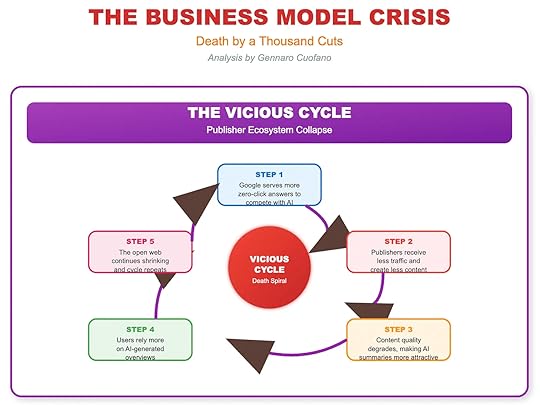
The internet’s foundational bargain — free content supported by ad-driven traffic — is breaking. What once looked like a stable ecosystem, where publishers created and search engines distributed, is now collapsing under the weight of zero-click results and AI-generated overviews.
This isn’t a sudden collapse. It’s death by a thousand cuts. The publisher economy isn’t disappearing overnight, but each cycle erodes it further, making recovery less likely.
At the heart of this lies a vicious cycle — a structural loop that accelerates ecosystem decay.
The Vicious Cycle of Publisher CollapseThe crisis unfolds in five reinforcing steps:
Step 1: Zero-Click Expansion
Google and other platforms surface answers directly, reducing the need to click through to publishers.What began as featured snippets has now expanded into AI-powered overviews, where answers are complete enough to end the journey at the search page.Step 2: Declining Publisher Traffic
As user clicks shrink, publishers lose audience and monetizable impressions.Less traffic means less ad revenue, making investment in content harder to justify.Step 3: Content Quality Degrades
With weaker economics, publishers cut budgets, churn out lower-quality content, or exit entirely.The result: fewer authoritative sources, creating a vacuum that AI-generated content can fill.Step 4: User Reliance on AI Summaries
As open-web content thins out, users default to AI-generated overviews.Trust shifts from publishers to platform-mediated synthesis.Step 5: The Shrinking Web
The open web contracts further, reducing diversity and resilience.The cycle repeats, tightening the spiral with each iteration.This is more than a revenue problem. It’s a structural crisis: the very supply of quality information that AI systems depend on is eroding.
Why This Crisis Is DifferentPublishers have faced platform shocks before — from Facebook algorithm changes to SEO volatility. But today’s crisis is deeper, for three reasons:
AI Eats ContextUnlike social platforms, AI doesn’t just distribute content — it consumes, summarizes, and substitutes it.The publisher’s role shrinks from destination to raw input.Zero-Click Becomes DefaultHistorically, “zero-click” was a feature. With AI overviews, it becomes the standard experience.The economics shift from millions of downstream visits to a single, upstream synthesis.Content Supply at RiskEarlier disruptions reshaped traffic flows but didn’t erode the incentive to produce.Today, the incentive itself collapses: why create if distribution no longer monetizes?The Long-Term ImplicationsIf unchecked, the vicious cycle reshapes the internet in three profound ways:
Information ConcentrationA shrinking number of publishers survive — primarily large, capitalized players.Diversity of voices diminishes, creating a more homogenized information landscape.AI DependencyUsers become conditioned to trust AI-mediated answers, even if the underlying source base is thinning.The paradox: AI looks more authoritative even as the foundation it draws from weakens.Platform MonopolizationPower shifts decisively to platforms (Google, OpenAI, Anthropic).Publishers become vendors of raw data, stripped of brand equity and user relationships.Can the Cycle Be Broken?Breaking the cycle requires new incentives for content creation. Several possible interventions exist:
Revenue-Sharing ModelsPlatforms may need to distribute a portion of AI-driven revenue back to publishers, as a survival mechanism to maintain supply.Micropayments & API Access
TollBit-style models could enable publishers to monetize content at the crawl or synthesis layer, not just at the click layer.Strategic Niches
Publishers who own unique, high-value data (industry benchmarks, proprietary research) may defend their economics by becoming indispensable to AI systems.Regulatory Pressure
Governments may intervene to enforce licensing models, ensuring that platforms cannot extract without compensation.The Coming Divide
The publishing world is splitting into two camps:
Commodity Content — mass-market news, generic explainers, lifestyle content. These are the first casualties of AI synthesis.Moat Content — proprietary data, deep expertise, or niche authority. These may survive, but require deliberate reinvention of the business model.The middle — ad-driven, SEO-optimized, generalist content — faces extinction.
The Strategic LensFor executives, the publisher crisis isn’t just a media story. It’s a structural signal:
If you depend on web distribution, your traffic pipeline is at risk.If your business model relies on SEO, your margins will shrink.If your brand doesn’t own unique data, you’ll be commoditized.The old playbook of scaling content for search visibility is collapsing. The new playbook demands distribution resilience: direct channels, proprietary ecosystems, and AI-era monetization strategies.
The Bottom LineThe open web was built on a fragile equilibrium: publishers created content, platforms distributed it, advertisers funded it. That equilibrium is breaking.
Zero-click results and AI overviews don’t just shift traffic — they undermine the incentive to create. Each cycle cuts deeper, leading to weaker publishers, thinner content, and greater AI dependence.
This is the business model crisis: death by a thousand cuts.
And unless new incentives emerge, the open web will continue to shrink — leaving AI systems to feed on an ever-diminishing pool of sources.

The post The Business Model Crisis: Death by a Thousand Cuts appeared first on FourWeekMBA.
Where Google Remains Essential: The Companion Role in the AI Era
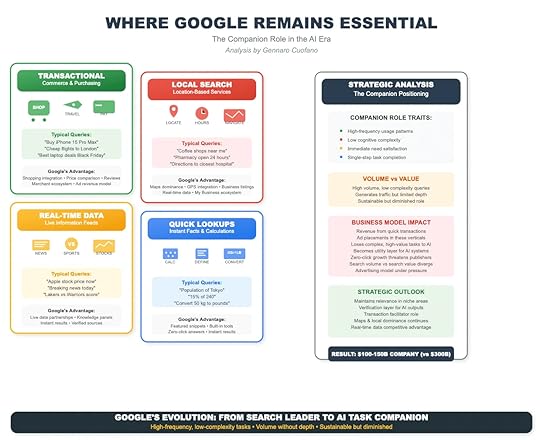
For over two decades, Google defined the digital experience. The search box wasn’t just a tool — it was the starting point for almost everything online. But in the AI era, the search box is shrinking. As AI handles complex, multi-step tasks, Google’s dominance shifts from gateway to companion.
This does not mean irrelevance. Google will remain essential, but in a narrower band of high-frequency, low-complexity queries. The future is not about search as the hub of the internet, but about search as a supporting layer for AI systems.
The Companion Role DefinedGoogle’s enduring strengths are rooted in queries that share four traits:
High frequency — they happen constantly, multiple times a day.Low complexity — they can be answered in a single step.Immediate need — users want instant resolution.Task completion — the output satisfies the query without further stitching.This “companion role” doesn’t make Google irrelevant. But it does make Google narrower, focused on tasks AI doesn’t fully absorb.
The Four Pillars of Essential Google1. Transactional Queries: Commerce and PurchasingWhen users want to buy, Google still owns the funnel. From “best laptop deals” to “cheap flights to London,” Google’s integration of shopping ads, price comparison, merchant reviews, and payment flows gives it an edge.
Advantage: deep merchant ecosystem + proven ad revenue model.Limitation: as AI shopping companions mature, Google risks losing discovery while retaining only checkout facilitation.2. Local Search: Location-Based ServicesFew competitors can match Google’s dominance in maps and local navigation. Queries like “coffee shops near me” or “directions to closest hospital” remain firmly in Google’s grip.
Advantage: GPS integration, Maps dominance, Google My Business listings.Limitation: AI could intermediate by fetching results from Google Maps without users directly searching.3. Real-Time Data: Live Information FeedsWhen immediacy matters, Google’s access to live data partnerships gives it a unique moat. From stock prices to breaking news, Google provides verified, instant snippets.
Advantage: partnerships with financial data providers, sports feeds, and news outlets.Limitation: as real-time APIs open up, AI systems could bypass Google — unless Google positions itself as the verification layer.4. Quick Lookups: Facts and CalculationsGoogle excels at instant answers: population sizes, unit conversions, definitions. These are single-step tasks where the user wants precision and speed.
Advantage: featured snippets, knowledge graphs, built-in tools.Limitation: AI can replicate this seamlessly, unless Google ensures its data remains the canonical source.Volume Without DepthThese areas represent massive volume, but limited depth.
Millions of people will still check directions, sports scores, and quick facts daily.But the strategic value of these queries is shallow. They generate ad impressions, not deep user journeys.This is the essence of Google’s future: sustainable, but diminished.
Business Model ImpactThe shift to a companion role has profound implications:
Revenue PressureGoogle monetizes through ad placements in these verticals.As complex, high-value tasks migrate to AI, Google loses margin-rich categories like research, planning, and decision-making.Zero-Click GrowthGoogle already faces rising zero-click behavior.In the AI era, Google risks being reduced to a background layer, cited by AI but not directly visited.Volume vs. Value DivergenceSearch volume may remain high.Search value, however, shifts to AI systems that capture context-rich tasks.The Strategic OutlookGoogle’s path forward rests on leaning into the companion role while monetizing its structural moats.
Verification Layer — becoming the trusted source AI systems cite.Transaction Facilitator — owning checkout flows and payment rails.Maps & Local Dominance — ensuring location data remains indispensable.Real-Time Advantage — deepening exclusive live-data partnerships.In this scenario, Google remains a $100–150B company — still huge, but not the $300B giant it once was.
What This Means for BusinessesOptimize for AI and Google TogetherBeing AI-citable requires structured data and authoritative content.Google optimization still matters for local, transactional, and quick-look tasks.Rethink Customer JourneysComplex queries (“Which CRM should we use?”) will increasingly start and end in AI systems.Businesses should adapt to a world where Google drives fewer discovery journeys.Plan for Dual VisibilityAI-first for context-rich, multi-step tasks.Google-first for high-frequency, transactional, and local visibility.The Companion FutureGoogle isn’t going away. It’s transforming.
From search leader to AI task companion.
From gateway to the web to utility layer for AI.
From deep discovery to fast resolution.
Google will still power millions of micro-moments daily — but the future of strategic value is elsewhere.
In the AI era, volume survives, depth migrates.
That is the paradox of Google’s companion role.

The post Where Google Remains Essential: The Companion Role in the AI Era appeared first on FourWeekMBA.
The Replacement Ratio: How AI Collapses Search Into Synthesis
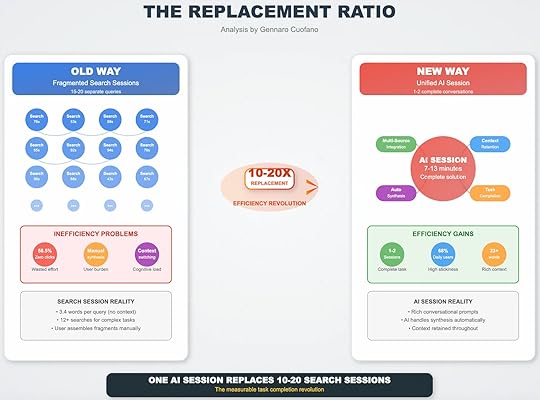
The internet was built on the ritual of search. You type a query, scan results, refine your wording, and repeat. Each task demands a chain of fragmented searches, scattered tabs, and mental stitching.
Now, that ritual is breaking. One AI session can replace 10–20 separate search queries. This is not just a usability upgrade — it’s an efficiency revolution that rewrites the economics of information.
The Old Way: Fragmented and InefficientTraditional search sessions follow a predictable pattern:
Short queries averaging 3–4 words, stripped of context.15–20 separate searches for a single complex task.Manual synthesis, where the user validates sources and reconciles contradictions.Context switching, bouncing between documentation, forums, and articles.The result is inefficiency at scale:
58.5% zero-clicks — wasted effort where queries produce no usable output.12+ queries per task, draining time and focus.A heavy cognitive load, as the user is forced to assemble fragments into solutions.The burden falls entirely on the user. Search engines provide fragments, not answers.
The New Way: Unified AI SessionsAI collapses this fragmented process into 1–2 unified sessions. Instead of typing 20 shallow queries, the user expresses a rich, conversational prompt — embedding intent, context, and goal.
In response, the AI handles what search never could:
Multi-Source Integration — pulling from varied knowledge pools simultaneously.Context Retention — remembering prior interactions in the conversation.Auto-Synthesis — merging fragments into coherent, actionable output.Task Completion — delivering not just information, but outcomes.One 7–13 minute AI session can accomplish what previously required half an hour of scattered searching and mental effort.
Quantifying the Replacement RatioThe shift is measurable.
1 AI session = 10–20 search queries.Efficiency gains of 3–4x, with faster outcomes and reduced cognitive overhead.Higher stickiness, with 68% of daily users returning to conversational systems.Richer context, as prompts average 23+ words instead of 3–4.The key insight: AI doesn’t just speed up search; it changes what “search” means. The function migrates from finding fragments to delivering synthesis.
From Fragmentation to FlowThink of the old search workflow as a broken assembly line. Each query is a piece, but the user is the factory stitching them into a finished product.
In the AI paradigm, the assembly line disappears. The user hands off intent, and the AI manufactures a complete solution.
Old Way: Input → Fragments → User Synthesis → OutcomeNew Way: Prompt → AI Synthesis → OutcomeThe user’s role shrinks from assembler to director. The value shifts from data access to task completion.
Why the Ratio MattersThe replacement ratio is not a technical curiosity. It’s a strategic signal of where value is migrating.
1. For UsersThe payoff is time and attention. Tasks that once consumed half an hour compress into conversational loops of under ten minutes. Cognitive load drops. Productivity rises.
2. For BusinessesThe SEO-driven game of visibility is eroding. When one AI session replaces 20 searches, fewer clicks flow to websites. The new challenge: being citable inside AI outputs, not just rankable in Google.
3. For PlatformsRevenue models built on click volume face pressure. If AI compresses search demand by an order of magnitude, advertising-driven economics must evolve toward verification, subscriptions, and task monetization.
The Efficiency RevolutionThe numbers crystallize the scale of change:
Old Session Reality: 12+ searches, 58% zero-clicks, user burden of synthesis.AI Session Reality: 1–2 conversations, context retention, automatic synthesis.This is not incremental improvement. It’s 10–20x efficiency.
Where search consumed effort, AI compounds efficiency. The “replacement ratio” quantifies the measurable productivity dividend unlocked by task unification.
Strategic TakeawaysDesign for Prompts, Not QueriesBusinesses must adapt content, products, and knowledge for AI-friendly synthesis. Structured data, clear context, and authoritative sources become the new visibility levers.Monitor Replacement Metrics
Track how many searches are being displaced by AI sessions in your workflows. The ratio is a leading indicator of disruption across industries.Shift to Task Value
Platforms will monetize not impressions but completed tasks — booking a table, generating code, making a purchase. Value creation follows completion, not clicks.The Paradigm Inversion
The replacement ratio captures the inversion at the heart of the AI era:
Search used to be about finding.AI sessions are about finishing.When one AI conversation can stand in for 20 search queries, the implications cascade across user behavior, business strategy, and platform economics.
This isn’t a UX upgrade. It’s the collapse of the search economy into the synthesis economy.
Final WordThe replacement ratio is more than a metric. It’s a lens into the future of digital interaction.
Every time a user trades 20 fragmented queries for one coherent AI session, the old web loses ground, and the AI-native web gains momentum.
One AI session replaces 10–20 searches. That is the measurable revolution.
The companies that understand this ratio — and design for it — will not just keep pace. They will define the next digital era.

The post The Replacement Ratio: How AI Collapses Search Into Synthesis appeared first on FourWeekMBA.
A Google Search Is Not a ChatGPT Prompt
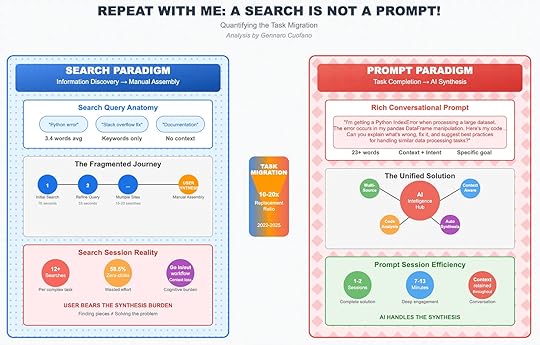
For decades, the search box has been the gateway to the web. Users typed short, contextless queries — “Python error,” “Stack overflow fix,” “Documentation” — and then stitched together answers across multiple tabs. This ritual defined digital work.
But in the AI era, that ritual collapses. A search is not a prompt. And the migration from search-driven discovery to prompt-driven synthesis is transforming not just how we interact with information, but how value is created online.
The Search Paradigm: Fragmentation and BurdenSearch queries are shallow by design. The average Google query contains 3–4 words, stripped of nuance, intent, or context.
The journey looks like this:
Initial Search → A keyword-based query, returning partial results (avg. 76 seconds).Refined Queries → Users rephrase, iterate, and add modifiers (avg. 53 seconds).Fragmented Sources → 15–20 different searches across multiple sites.Manual Synthesis → Users themselves must reconcile contradictions, verify accuracy, and assemble solutions.This creates what I call the synthesis burden. Users do not receive answers; they cobble them together.
The inefficiency is measurable:
12+ searches per complex task.58.5% zero-click rate, where no result provides usable value.Context switching across tabs, breaking workflow and attention.The user carries all the cognitive load.
The Prompt Paradigm: Task Completion, Not DiscoveryAI flips this model. Instead of issuing fragmented queries, users provide rich conversational prompts:
“I’m getting a Python IndexError when processing a large dataset. The error occurs in my pandas DataFrame manipulation. Here’s my code… Can you explain what’s wrong, fix it, and suggest best practices for handling similar tasks?”
This is not a search. It’s a direct expression of intent, context, and goal.
From that single input, the AI intelligence hub engages:
Multi-Source Processing — pulling from documentation, examples, and prior knowledge.Context Awareness — retaining conversation flow and prior clarifications.Auto-Synthesis — merging fragments into a coherent, actionable solution.Code Analysis — in technical use cases, testing and fixing errors directly.The user receives not a list of links but a unified solution.
Task Migration: Quantifying the ShiftThe migration from search to prompts is not linear — it’s multiplicative.
One prompt can replace 10–20 searches. Instead of bouncing across Stack Overflow, Reddit, and documentation, the user compresses the journey into a single conversational session.
Metrics illustrate the efficiency:
1–2 sessions deliver complete solutions.7–13 minutes of focused interaction replaces 20+ minutes of scattered searching.Context retention ensures continuity across interactions.The key difference: AI handles the synthesis. Users no longer assemble fragments; they receive finished answers.
Why a Search ≠ a PromptIt’s tempting to conflate search queries with AI prompts. After all, both involve typing into a box. But the mechanics — and the economics — are fundamentally different.
Search = Discovery. Users hunt for fragments, validate them, and assemble outcomes.Prompt = Completion. Users express intent; AI delivers integrated outcomes.This changes everything:
For users, cognitive load collapses.For businesses, discoverability strategies must shift from ranking in SERPs to being citable in AI synthesis.For platforms, the revenue model shifts from click arbitrage to task monetization.The Synthesis DividendThis migration creates a productivity dividend. By offloading synthesis to AI, humans reclaim both time and attention.
Developers resolve bugs faster.Analysts synthesize reports in fewer steps.Consumers make purchase decisions in seconds, not days.The old bottleneck was information access. The new bottleneck is quality of synthesis.
Strategic ImplicationsFor UsersWorkflows accelerate. Complex tasks compress into conversational loops. The skill shifts from finding information to framing prompts.
For BusinessesThe SEO arms race loses relevance. The new game is AI readiness — ensuring your brand, product, or expertise is present in the data streams AI draws from. Structured content, citations, and partnerships with AI platforms become essential.
For PlatformsGoogle, Amazon, and others face a disruptive truth: queries are shrinking while prompts are expanding. Ad revenue built on keyword targeting erodes. The monetization of the future will flow through AI-driven task layers — subscription, verification, and transaction fees.
A Search Is Not a PromptThis shift demands a mental reset. Typing “Python error” and typing a 23-word conversational request may feel similar. But they belong to different paradigms.
Search is about finding.Prompts are about solving.Once you see this difference, the scale of task migration becomes obvious. The companies that treat prompts as an evolution of search will miss the point. The companies that design for task completion will own the future.
Final WordThe web era was built on search boxes. The AI era will be built on prompts.
Search was fragmented, shallow, and burdened the user with synthesis. Prompts are contextual, conversational, and outsource synthesis to AI.
This is not a UX tweak. It’s a paradigm inversion.
A search is not a prompt. And recognizing that distinction is the first step to understanding where digital value — and competitive advantage — is migrating.

The post A Google Search Is Not a ChatGPT Prompt appeared first on FourWeekMBA.
The Great Digital Paradigm Shift
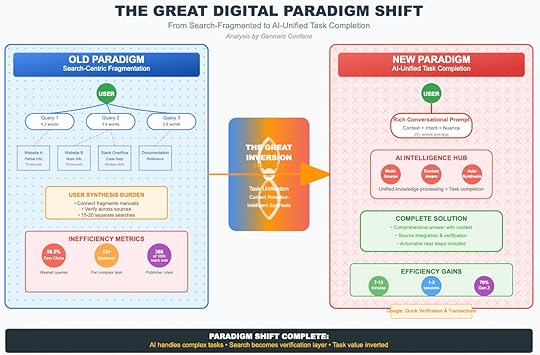
For over two decades, the digital economy has been built on search. The model was simple: users typed queries, scanned results, clicked links, and pieced together answers. Google sat at the center of this system, extracting value from billions of fragmented searches every day.
But that model is breaking. AI is rewriting the logic of digital interaction, shifting us from search-fragmented workflows to AI-unified task completion. This change isn’t incremental — it’s a paradigm shift.
The Old Paradigm: Fragmentation and BurdenIn the search-centric era, the burden of synthesis fell squarely on the user. A typical journey looked like this:
Multiple Queries. Users rephrased questions (average 3–5 queries per task).Fragmented Sources. Each click yielded partial answers — a snippet here, a reference there.Manual Synthesis. Users stitched fragments together, verified sources, and reconciled contradictions.This created a hidden tax on productivity. Research showed:
12+ searches were required for most complex tasks.58.5% of queries ended in zero clicks, signaling wasted effort.Out of 1,000 sites on the web, only 360 captured meaningful traffic, leaving the long tail starved.The result was a paradox: endless information, but high cognitive load for the user and inefficient discovery for businesses.
The Great InversionAI introduces an inversion of this dynamic. Instead of users doing the work of synthesis, AI agents handle unification, context retention, and intelligent synthesis.
The shift can be summarized in three words:
From Search → To ConversationFrom Fragmentation → To IntegrationFrom Burden → To CompletionThis is not about improving the old model. It’s about replacing the very mechanics of how digital knowledge is accessed and applied.
The New Paradigm: AI-Unified Task CompletionIn the AI paradigm, the process begins not with fragmented queries but with a rich conversational prompt. Users provide intent, context, and nuance in a single interaction.
That input flows into an AI Intelligence Hub with three core capabilities:
Multi-Source Processing. Pulling from multiple databases, documents, and knowledge graphs simultaneously.Context Awareness. Retaining memory of prior prompts, user preferences, and task progression.Auto-Synthesis. Delivering unified answers — not fragments — that integrate sources and recommend next steps.The outcome is a complete solution:
Comprehensive, contextual answersIntegrated verification across sourcesActionable recommendations or transactionsWhat once required 15–20 searches can now be resolved in one or two sessions.
Efficiency Gains: Time, Sessions, SatisfactionThe efficiency impact is profound:
Time Reduction. Complex research tasks shrink from 15–20 minutes to 7–13 minutes.Session Compression. Instead of multiple queries across platforms, users resolve needs in 1–2 AI sessions.Behavioral Shift. Among Gen Z, 70% now prefer AI interactions for discovery over traditional search engines.In short: search is no longer the destination. It is becoming the verification layer.
Strategic ImplicationsThe implications of this shift ripple across the digital ecosystem.
1. For UsersCognitive load collapses. Tasks that once required managing tabs, juggling sources, and synthesizing information now resolve in a single conversational loop. The user becomes consumer of outcomes, not processor of fragments.
2. For BusinessesVisibility dynamics are inverted. Brands can no longer rely on SEO alone to surface in fragmented search. Instead, they must ensure AI systems can cite them as authoritative sources. Structured data, direct integrations, and knowledge graph strategies become critical.
3. For PlatformsThe economics of the web shift. Google’s role transitions from orchestrating discovery to validating AI outputs and enabling transactions. The monetization logic will follow — from click-based advertising to value capture at the verification and transaction layers.
The Paradigm Shift CompleteWe are not speculating about the future. The shift is already underway. Users are adopting AI-first behaviors, Gen Z is bypassing search altogether, and businesses are confronting declining traffic from traditional funnels.
The new digital paradigm can be summed up in three points:
AI handles complex tasks.Search becomes verification, not discovery.Task value is inverted — completion, not clicks, defines success.Preparing for the InversionTo thrive in this paradigm, organizations must adapt quickly. The roadmap includes:
AI-Ready Content. Publish structured, citable knowledge that AI agents can parse.Conversational Interfaces. Build direct AI channels to engage customers.Verification Strategy. Position your brand as the source AI validates against.The winners will not be those with the most traffic, but those with the most trust in AI-mediated ecosystems.
Final WordThe Great Digital Paradigm Shift is not just technological. It’s cognitive and economic. For the first time since the birth of the web, the burden of synthesis is leaving the user.
This inversion will define the next decade: an era where tasks are unified, context persists, and completion replaces fragmentation.
The companies that recognize this early will shape the future. The rest will be optimized out of existence — not by competitors, but by the very AI agents their customers now trust.

The post The Great Digital Paradigm Shift appeared first on FourWeekMBA.



